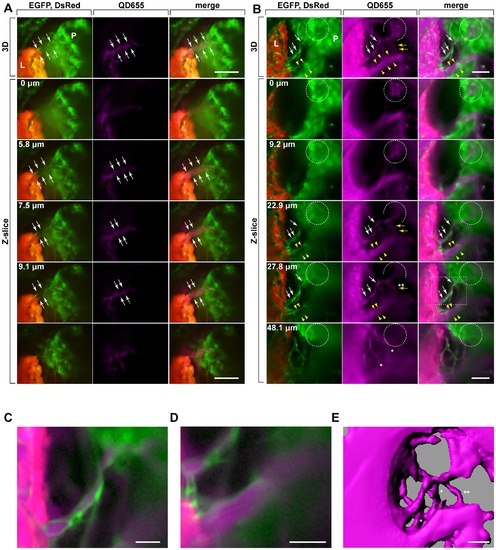Fig. 2
- ID
- ZDB-FIG-130910-16
- Publication
- Omae et al., 2013 - Identification of Inter-Organ Vascular Network: Vessels Bridging between Organs
- Other Figures
- All Figure Page
- Back to All Figure Page
|
Delineation of V1LP, V2LP and V4LP vascular connections by quantum dots. QD655 injected Tg(lfabf:DsRed;elaA:egfp);Tg(fli1:efgp) larva is shown. The 3D rendered confocal microscopy images (the top panel: 3D) and their serial optical sections (bottom panels: Z-slice) of Tg(lfabf:DsRed;elaA:egfp);Tg(fli1:egfp) at 6 dpf are shown. The bottom five panels are Z-slices of the 3D rendered images shown at the top panel. The depth of each slice is indicated as Ám at the top left in each panel of Z-slice. V1LP and V2LP vessels are sandwiched between white arrows and outlined by white arrows, respectively. V4LP vessel is outlined by yellow arrows and sandwiched between yellow arrowheads. The islet of Langerhans is indicated (dotted circle in each panel). The islet of Langerhans, consisting of endocrine cells, was identified as an area devoid of EGFP reporter signals driven by the exocrine pancreas-specific elaA promoter. The left, middle and right panels in A and B show EGFP (green: fli1+ vessels, elaA+ exocrine-pancreas)/DsRed (orange: lfabf+ liver), QD655 (magenta) and merged images, respectively. A. The QD655 perfused V1LP vessel. The fli1+ V1LP vessel (green) is perfused with Q655 (magenta) albeit only faintly. B. The QD655 perfused V2LP and V4LP vessels. V2LP and V4LP vessels are outlined by white and yellow arrows, respectively. By following each serial Z-slices, the direct connection of V2LP vessel (white arrows) to vascular plexus at the islet of Langerhans (dotted circle) is discernable. V4LP vessel (yellow arrows and sandwiched between yellow arrowheads) is clearly connected to intrahepatic vasculature. There are three branches (two indicated by *, one indicated by**) stemming from V4LP that appear to bridge between V2LP and V4LP vessels. By following the serial Z-slices, it is clear that two of these QD655 perfused vessels indicated by * become more discernable as V2LP becomes fainter (compare the 4th and 5th Z-slices in the QD655 column), suggesting that those two indicated by * are not directly linked to either V2LP or V4LP vessels. Instead, they cross behind V2LP vessel. In contrast, the one indicated by ** appears to be on the same Z-slice plane as V2LP vessel (compare the 4th and 5th Z-slices in the QD655 column), suggesting that this vessel (**) is a branch that directly bridge between V2LP and V4LP vessels. C. Higher magnification of the V2LP vessel showing co-localization of fli1+ vascular endothelial cells (green) and QD655 signal (magenta) (of the 4th panel of the merge column as indicated by dotted rectangle). D. Higher magnification of the V4LP vessel showing co-localization of fli1+ vascular endothelial cells (green) and QD655 signal (magenta) (of the 3rd panel of the merge column as indicated by dotted rectangle). E. IsoSurface object image of QD655 perfused vessel connections of V2LP and V4LP and their branches. The QD655 perfused vessel image was treated by surface rendering method and IsoSurface object was built (Threshold = 12). In this surface rendered image, all three branches (? and **) stemming from V4LP vessel appear to be fused to V2LP vessel. However, as demonstrated by Z-slices shown in C., two (?) are crossing behind V2LP vessel, and the one (**) fuses with V2LP vessel. Scale bars: A, B: 50 μm; C?E: 25 μm. |

